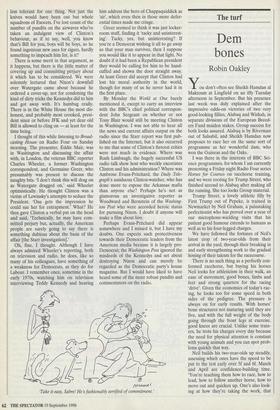The turf
Dem bones
Robin Oakley
You don't often see Sheikh Hamdan al Maktoum at Lingfield on an iffy Tuesday afternoon in September. But his presence last week was duly explained after the impressive odds-on victories of two very good-looking fillies, Alabaq and Wishah, in separate divisions of the European Breed- ers Fund maiden stakes. Group success for both looks assured. Alabaq is by Riverman out of Salsabil, and Sheikh Hamdan now proposes to race her on the same sort of programme as her wonderful dam, who won the Guineas and the Oaks.
I was there in the interests of BBC Sci- ence programmes, for whom I am currently presenting a Friday night Radio Four series Horses for Courses on racehorse training, and we were rooting for Trump Street, who finished second to Alabaq after making all the running. She too looks Group material.
Trump Street, a lovely athletic filly by First Trump out of Pepeke, is trained in Newmarket by Neil Graham, a painstaking perfectionist who has proved over a year of our microphone-wielding visits that his patient good humour extends to humans as well as to his four-legged charges.
We have followed the fortunes of Neil's latest crop of two-year-olds from their arrival in the yard, through their breaking in and early strengthening work to the gradual honing of their talents for the racecourse.
There is no such thing as a perfectly con- formed racehorse, but buying his horses Neil looks for athleticism in their walk, an ease of movement, good bones, limbs and feet and strong quarters for the racing `drive'. Given the economics of today's rac- ing, he looks too for some speed in both sides of the pedigree. The pressure is always on for early results. With horses' bone structures not maturing until they are five, and with the full weight of the body going through the front legs at exercise, good knees are crucial. Unlike some train- ers, he trots his charges every day because the need for physical attention is constant with young animals and you can spot prob- lems quickly that way.
Neil builds his two-year-olds up steadily, assessing which ones have the speed to be put to the test early over 5f and 6f. March and April are confidence-building time. `You're teaching them how to race, how to lead, how to follow another horse, how to move out and quicken up. One's also look- ing at how they're taking the work, that we're not frightening them.' Push them too hard too soon and you can destroy their actions, he warns. And there is the mental aspect too. Over-burdened horses will boil over and you will have to ease off and rebuild that damaged confidence slowly.
Intelligence too has to be assessed. 'Good racehorses tend to be quite intelligent and have some natural feel for what one's ask- ing them and to do it very easily and natu- rally. The more slowly maturing ones take longer to grasp the nettle.' Some more laid- back horses need more aggressive work to build their combative spirit because horses, as herd animals, are not natural leaders keen to burst clear of the pack.
How soon does he get that prickle on the back of the neck that tells him he has a good one? 'Pretty early on. You'll have a feeling by March if a horse is likely to be good. In the next few weeks you know if they're going to be good ... good racehors- es are natural athletes, they usually find their work incredibly easy.'
Neil admits that it is financial pressures which make us race horses as comparative babies at two years old. Breeders want to sell on early. Owners want an early return on the money they have laid out to buy themselves some fun on the racecourse. But what came as a surprise to me is that the vets are quite happy with that too. Neil's vet Richard Greenwood says there is no doubt that some horses are perfectly capable of racing at two. 'They are early maturing. Their bones are strong enough and they per- form well and to a consistent level. There is no reason why they should not race.' The training process, he points out, strengthens and matures the bone so if you leave a horse in a field until it is three you still have to go train it to develop its bones for racing. Pro- fessor Leo Jeffcoat, of Cambridge Universi- ty, told us it could actually benefit racehorses to begin training even earlier than they do, at 10 to 14 months instead of the 18 to 20 months which is the current norm.
It is one of the essential skills of a train- er, says Richard Greenwood, sorting out which of his charges should be racing seri- ously at two and which should not. It is a skill which Neil Graham patently has and the only puzzling thing about our visits to his Coronation Stables was that only 15 of the boxes were filled. This is, after all, a trainer who learned his trade with the likes of Dick Hern and John Gosden. He has already had a Classic success with Minster Son's victory and has trained a number of Group winners. He is the business. The problem is that while he happens to be one of the nicest men in racing he is not a huckster or self-promoter. Hopefully the syndicates attached to the recently launched Flying Colours racing club in which his wife, Channel 4 racing presenter Lesley Graham, is actively involved, will add the necessary quantity to the quality already housed in Coronation Stables.
Robin Oakley is political editor of the BBC.











































































 Previous page
Previous page